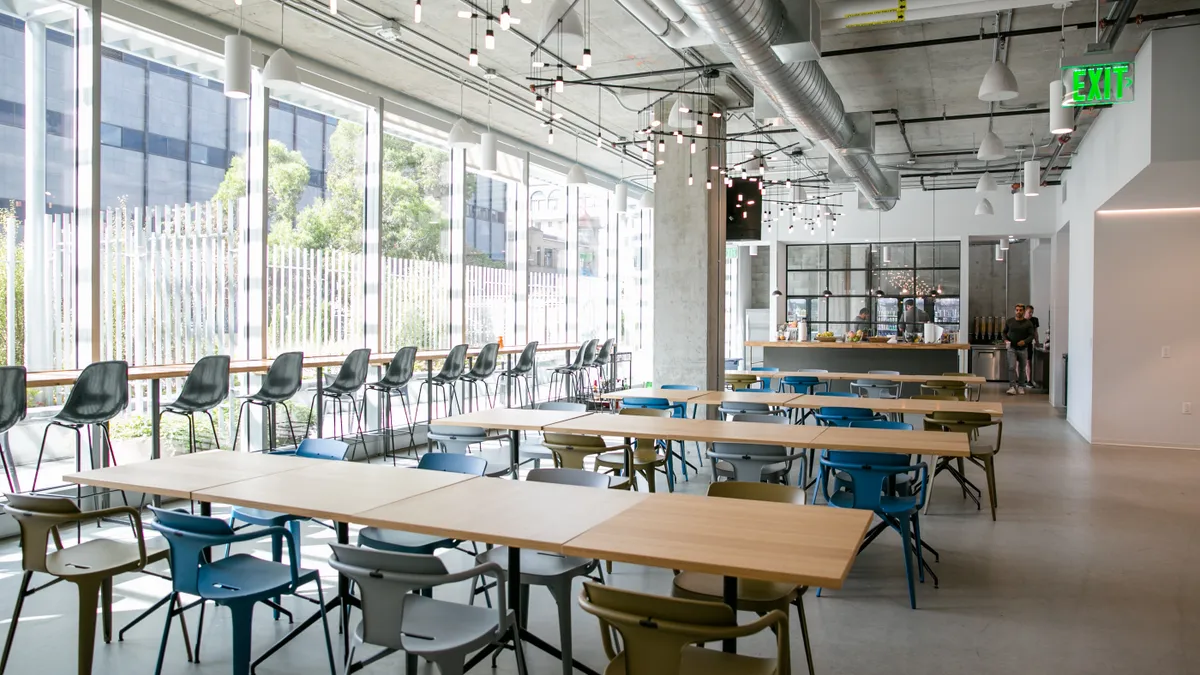Cutting or keeping office spending flat by fitting more workers into the same office space — at times growing in place — is emerging as a longer-term budget bright spot for finance chiefs wrestling with soaring inflation across many fronts.
The opportunity comes as companies are taking a wide range of approaches to real estate as they execute return-to-office plans. Alphabet's Google last week signaled a seemingly contrarian move in a blog post announcing plans to invest about $9.5 billion in U.S. offices and data centers while others such as Salesforce, Inc. have sought to take advantage of the accelerated move to remote work in the pandemic by moving to sublease big blocks of space.
But whatever shape their footprints take, many companies are offering their workers some type of hybrid flexibility, which can ultimately enable them to support more workers in the same space. The real estate services company Cambridge Innovation Center (CIC), which provides flexible office and co-working spaces, sees a variety of set-ups from a one-to-one person to desk ratio to a 4-to-1 ratio and even has a 60-person company sharing a corner office with five desks, a spokesperson said.
The Cambridge, Massachusetts-based company is also getting more inquiries about the array of flexible office leases it offers, including one-month terms from larger companies that previously leaned toward multi-year leases on bigger offices, according to Camilla Jensen, CIC's CFO. The seismic shifts in how and where people work is still evolving but she expects to see more executives taking steps to realize real estate savings this year.
"In the next couple months we'll all know more about how companies will shift and how CFOs and executives will make decisions to save money," Jensen said. "Right now it's tidbits we're seeing, trends where people are acting on more flexibility.”
While demand varies by market, it's still to a great degree a buyer or tenant's market. U.S. office vacancy rates rose for their tenth consecutive quarter to 17.5% in the first quarter, from 15.8% in the year-earlier period, and effective office rents have declined by 13.3% since peaking in the second quarter of 2020, according to a Cushman & Wakefield report. However, vacancy rates are expected to peak in many markets midyear, as demand firms, and year-over-year rent declines are moderating, the report states.
Investing in people, not square feet
At the executive search and advisory firm Spencer Stuart, newly-tapped CFO Christine Laurens sees the potential for saving on real estate costs in the future as a welcome contrast to other rising expenses she faces such as wage and technology increases. People are her firm's largest expense followed by real estate and technology, she said.
Like many companies, Spencer Stuart surveyed and got clear feedback that its workers want flexibility, said Laurens, who believes hybrid work will likely be the path for the firm going forward. As such, she anticipates that the firm will need slightly less space in the future or will remain in the same space but grow. "My point of view is that I'd rather invest in our people and in training and development than in square feet," Laurens said.
Meanwhile at growing biotech firm Axogen CFO Pete Mariani briefly toyed with subleasing some office space to cut the company's real estate costs early in the pandemic. Instead the company, which has over 400 full-time employees, decided against limiting its growth for short-term savings by giving back space.
But at the same time, he expects he won't need more space anytime soon, in part because the firm initiated a new return-to-office model last month which requires all workers to be in the office three days a week from 9 a.m. to 3 p.m. With that, Mariani expects to be able to accommodate more people, delaying the need to expand beyond its two Florida headquarters campuses, one of which is in Tampa, Florida.
"We certainly would, several years down the road, see the need to grow,” Mariani said. "Now maybe that time for us to expand goes out even longer given the flexibility we are creating with these work hours.”
Other companies, like Blend Labs, a San Francisco-based provider of mortgage and lending software to financial institutions, have already begun to save on real estate costs as fewer people are working from their offices. The company primarily operates with a "remote-first" model, offering flexibility with some exceptions that allows employees to work from home or the office, according to a spokesperson.
That's enabled Blend to accommodate many more employees in its 47,400 square foot San Francisco headquarters space even as the company's headcount has risen dramatically in recent years, according to Blend's head of finance Marc Greenberg. That's particularly important now as the firm is carefully reviewing its costs in the face of headwinds from the volatile economy and rising interest rates that are disrupting the mortgage market.
"We're trying to be as thoughtful as we can on our costs,” Greenberg said. "On a relative basis, we are saving a lot of money on facilities costs."






















